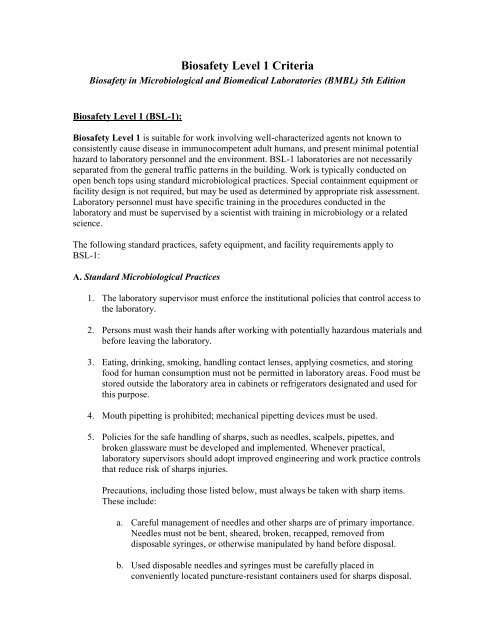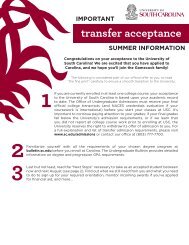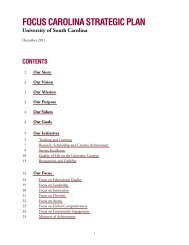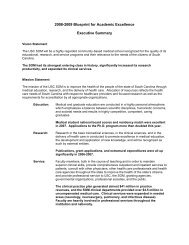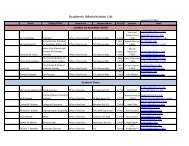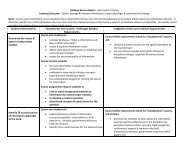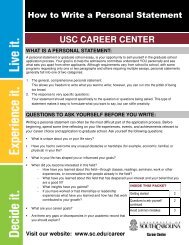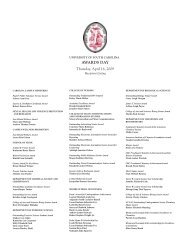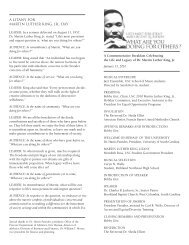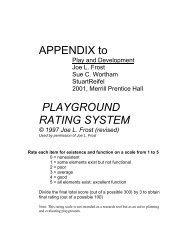Biosafety Level 1 Criteria
Biosafety Level 1 Criteria
Biosafety Level 1 Criteria
You also want an ePaper? Increase the reach of your titles
YUMPU automatically turns print PDFs into web optimized ePapers that Google loves.
<strong>Biosafety</strong> <strong>Level</strong> 1 <strong>Criteria</strong><br />
<strong>Biosafety</strong> in Microbiological and Biomedical Laboratories (BMBL) 5th Edition<br />
<strong>Biosafety</strong> <strong>Level</strong> 1 (BSL-1):<br />
<strong>Biosafety</strong> <strong>Level</strong> 1 is suitable for work involving well-characterized agents not known to<br />
consistently cause disease in immunocompetent adult humans, and present minimal potential<br />
hazard to laboratory personnel and the environment. BSL-1 laboratories are not necessarily<br />
separated from the general traffic patterns in the building. Work is typically conducted on<br />
open bench tops using standard microbiological practices. Special containment equipment or<br />
facility design is not required, but may be used as determined by appropriate risk assessment.<br />
Laboratory personnel must have specific training in the procedures conducted in the<br />
laboratory and must be supervised by a scientist with training in microbiology or a related<br />
science.<br />
The following standard practices, safety equipment, and facility requirements apply to<br />
BSL-1:<br />
A. Standard Microbiological Practices<br />
1. The laboratory supervisor must enforce the institutional policies that control access to<br />
the laboratory.<br />
2. Persons must wash their hands after working with potentially hazardous materials and<br />
before leaving the laboratory.<br />
3. Eating, drinking, smoking, handling contact lenses, applying cosmetics, and storing<br />
food for human consumption must not be permitted in laboratory areas. Food must be<br />
stored outside the laboratory area in cabinets or refrigerators designated and used for<br />
this purpose.<br />
4. Mouth pipetting is prohibited; mechanical pipetting devices must be used.<br />
5. Policies for the safe handling of sharps, such as needles, scalpels, pipettes, and<br />
broken glassware must be developed and implemented. Whenever practical,<br />
laboratory supervisors should adopt improved engineering and work practice controls<br />
that reduce risk of sharps injuries.<br />
Precautions, including those listed below, must always be taken with sharp items.<br />
These include:<br />
a. Careful management of needles and other sharps are of primary importance.<br />
Needles must not be bent, sheared, broken, recapped, removed from<br />
disposable syringes, or otherwise manipulated by hand before disposal.<br />
b. Used disposable needles and syringes must be carefully placed in<br />
conveniently located puncture-resistant containers used for sharps disposal.
c. Non disposable sharps must be placed in a hard walled container for transport<br />
to a processing area for decontamination, preferably by autoclaving.<br />
d. Broken glassware must not be handled directly. Instead, it must be removed<br />
using a brush and dustpan, tongs, or forceps. Plasticware should be<br />
substituted for glassware whenever possible.<br />
6. Perform all procedures to minimize the creation of splashes and/or aerosols.<br />
7. Decontaminate work surfaces after completion of work and after any spill or splash<br />
of potentially infectious material with appropriate disinfectant.<br />
8. Decontaminate all cultures, stocks, and other potentially infectious materials before<br />
disposal using an effective method. Depending on where the decontamination will be<br />
performed, the following methods should be used prior to transport:<br />
a. Materials to be decontaminated outside of the immediate laboratory must be<br />
placed in a durable, leak proof container and secured for transport.<br />
b. Materials to be removed from the facility for decontamination must be packed<br />
in accordance with applicable local, state, and federal regulations.<br />
9. A sign incorporating the universal biohazard symbol must be posted at the entrance to<br />
the laboratory when infectious agents are present. The sign may include the name of<br />
the agent(s) in use, and the name and phone number of the laboratory supervisor or<br />
other responsible personnel. Agent information should be posted in accordance with<br />
the institutional policy.<br />
10. An effective integrated pest management program is required. See Appendix G.<br />
11. The laboratory supervisor must ensure that laboratory personnel receive appropriate<br />
training regarding their duties, the necessary precautions to prevent exposures, and<br />
exposure evaluation procedures. Personnel must receive annual updates or additional<br />
training when procedural or policy changes occur. Personal health status may impact<br />
an individual’s susceptibility to infection, ability to receive immunizations or<br />
prophylactic interventions. Therefore, all laboratory personnel and particularly<br />
women of child-bearing age should be provided with information regarding immune<br />
competence and conditions that may predispose them to infection. Individuals having<br />
these conditions should be encouraged to self-identify to the institution’s healthcare<br />
provider for appropriate counseling and guidance.<br />
B. Special Practices<br />
None required.
C. Safety Equipment (Primary Barriers and Personal Protective Equipment)<br />
1. Special containment devices or equipment, such as BSCs, are not generally required.<br />
2. Protective laboratory coats, gowns, or uniforms are recommended to prevent<br />
contamination of personal clothing.<br />
3. Wear protective eyewear when conducting procedures that have the potential to<br />
create splashes of microorganisms or other hazardous materials. Persons who wear<br />
contact lenses in laboratories should also wear eye protection.<br />
4. Gloves must be worn to protect hands from exposure to hazardous materials. Glove<br />
selection should be based on an appropriate risk assessment. Alternatives to latex<br />
gloves should be available. Wash hands prior to leaving the laboratory. In addition,<br />
BSL-1 workers should:<br />
a. Change gloves when contaminated, integrity has been compromised, or when<br />
otherwise necessary.<br />
b. Remove gloves and wash hands when work with hazardous materials has<br />
been completed and before leaving the laboratory.<br />
c. Do not wash or reuse disposable gloves. Dispose of used gloves with other<br />
contaminated laboratory waste. Hand washing protocols must be rigorously<br />
followed.<br />
D. Laboratory Facilities (Secondary Barriers)<br />
1. Laboratories should have doors for access control.<br />
2. Laboratories must have a sink for hand washing.<br />
3. The laboratory should be designed so that it can be easily cleaned. Carpets and rugs<br />
in laboratories are not appropriate.<br />
4. Laboratory furniture must be capable of supporting anticipated loads and uses. Spaces<br />
between benches, cabinets, and equipment should be accessible for cleaning.<br />
a. Bench tops must be impervious to water and resistant to heat, organic<br />
solvents, acids, alkalis, and other chemicals.<br />
b. Chairs used in laboratory work must be covered with a non-porous material<br />
that can be easily cleaned and decontaminated with appropriate disinfectant.<br />
5. Laboratories windows that open to the exterior should be fitted with screens.


